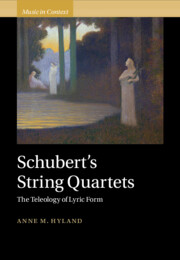Book contents
- Schubert’s String Quartets
- Music in Context
- Schubert’s String Quartets
- Copyright page
- Dedication
- Epigraph
- Contents
- Figures
- Tables
- Music Examples
- Acknowledgements
- Note on the Text
- Introduction: Schubert as Vanishing Point
- Part I Contexts
- Part II Analysis
- 3 Musical Closure and Functional Transformation: Reanimating the Dynamics of the Lyric
- 4 Schubert the Progressive: Parataxis and the Dialectics of Lyric Teleology
- 5 The Temporality of Lyric Teleology: Once More between Sonata and Variation in Schubert’s Quartets
- Epilogue
- Appendix Schubert’s Compositions for String Quartet
- Bibliography
- Index
3 - Musical Closure and Functional Transformation: Reanimating the Dynamics of the Lyric
from Part II - Analysis
Published online by Cambridge University Press: 13 April 2023
- Schubert’s String Quartets
- Music in Context
- Schubert’s String Quartets
- Copyright page
- Dedication
- Epigraph
- Contents
- Figures
- Tables
- Music Examples
- Acknowledgements
- Note on the Text
- Introduction: Schubert as Vanishing Point
- Part I Contexts
- Part II Analysis
- 3 Musical Closure and Functional Transformation: Reanimating the Dynamics of the Lyric
- 4 Schubert the Progressive: Parataxis and the Dialectics of Lyric Teleology
- 5 The Temporality of Lyric Teleology: Once More between Sonata and Variation in Schubert’s Quartets
- Epilogue
- Appendix Schubert’s Compositions for String Quartet
- Bibliography
- Index
Summary
Chapter 3 challenges the critical commonplace in accounts of the lyric that Schubert’s thematic groups compose closed, self-contained entities that yield static forms.In particular, it re-examines the perceived equivalence of the term ‘closed’ with cadential closure and the Perfect Authentic Cadence (PAC). It argues that Schubert’s lyric forms compose ’closed’ ABA structures while simultaneously undermining or downplaying the role of cadence as a marker of finality. The first section clears the theoretical path by examining the primary and secondary parameters of closure and their non-congruence. Three analytical case studies follow and address, respectively, the concept of functional retrogression in Schubert’s earliest quartets, the composer’s particular ways of articulating or downplaying the medial caesura (MC), and his use of the elided PAC MC, explored through the formally unorthodox Quartettsatz. Each analytical case study demonstrates the destabilisation of moments of punctuation in Schubert’s lyric forms as well as the charged conflict between tonal and rhetorical parameters, which often creates a critical tension between punctuation and continuation.
Keywords
- Type
- Chapter
- Information
- Schubert's String QuartetsThe Teleology of Lyric Form, pp. 107 - 159Publisher: Cambridge University PressPrint publication year: 2023

